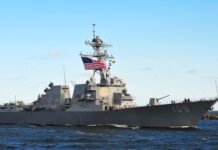
In a significant blow to China’s naval ambitions, U.S. officials have revealed that the country's newest nuclear-powered submarine, the Zhou-class, sank while docked at a shipyard earlier this year. The incident reportedly occurred between May and June 2024, but was concealed by Chinese authorities in an attempt to avoid embarrassment, raising concerns about the safety and standards of China's growing military fleet.
The Zhou-class submarine, China’s latest nuclear-powered attack vessel, was under construction at the Wuchang Shipyard near Wuhan when it sank alongside the pier. U.S. defense officials, citing satellite imagery, disclosed that large cranes were seen at the site, likely involved in efforts to recover the submarine from the riverbed. The sinking marks a critical setback for China’s People’s Liberation Army Navy (PLAN), which has been actively expanding its naval capabilities.
🚨China's newest Nuclear Power attack submarine sinks in Dockyard pic.twitter.com/P0u9ECPllW
— Alpha Defense™ (@alpha_defense) September 26, 2024
While China has not officially confirmed the incident, a spokesperson for the Chinese Embassy in Washington claimed they had "no information" to provide on the matter, further fueling speculation of a deliberate cover-up. The Zhou-class submarine, the first of its kind, represents a significant investment in China's ambition to project power across the Pacific and beyond. The incident is not only a blow to China’s naval expansion plans but also exposes potential weaknesses in training, oversight, and equipment standards within the PLA.
Experts believe that China’s attempt to hide the sinking underscores the nation’s internal challenges. According to U.S. defense officials, the cover-up is not surprising given the corruption and lack of accountability that have plagued China’s defense industry for years. The loss of the submarine adds to mounting concerns over whether China can sustain the pace of its rapid military buildup without compromising quality and safety.
Humiliation for Xi Jinping as China's newest nuclear-powered submarine SINKS at Wuhan port ⚓️😂😂 pic.twitter.com/dSDEoWEkrr
— Ryodevil69 (@ryodevil69) September 27, 2024
The Zhou-class submarine was poised to enhance China’s ability to challenge U.S. and allied forces in the Pacific. China currently operates six nuclear-powered attack submarines and six ballistic missile submarines, part of its growing fleet aimed at deterring adversaries. The new Zhou-class vessel was expected to be a cornerstone of this naval expansion, capable of conducting long-range missions with greater stealth and firepower. Its sinking, however, casts doubt on the reliability of China’s latest technologies.
This incident comes at a time when tensions in the Indo-Pacific region are already high. The U.S., U.K., and Australia have formed a trilateral security pact (AUKUS), which includes plans for Australia to acquire nuclear-powered submarines. This partnership aims to counter China’s growing influence in the South China Sea and surrounding waters. The sinking of the Zhou-class submarine could complicate China's efforts to keep pace with the technological advancements made by Western powers under the AUKUS deal.
China’s naval ambitions have been a focal point of international attention, particularly as the country has adopted a policy of keeping at least one nuclear-capable submarine at sea at all times. These submarines, equipped with nuclear missiles, are capable of striking targets as far as the U.S. mainland from the South China Sea. The loss of such a critical asset will likely force Chinese naval planners to reassess their strategies as they continue to build out their nuclear deterrent.
Despite the setback, China remains committed to advancing its naval capabilities. The PLAN has been steadily modernizing its fleet, transitioning from older Soviet-era technology to more advanced, homegrown designs. However, the sinking of the Zhou-class submarine highlights the challenges inherent in rapidly scaling a military force, especially when quality control and safety standards are compromised in the process.











